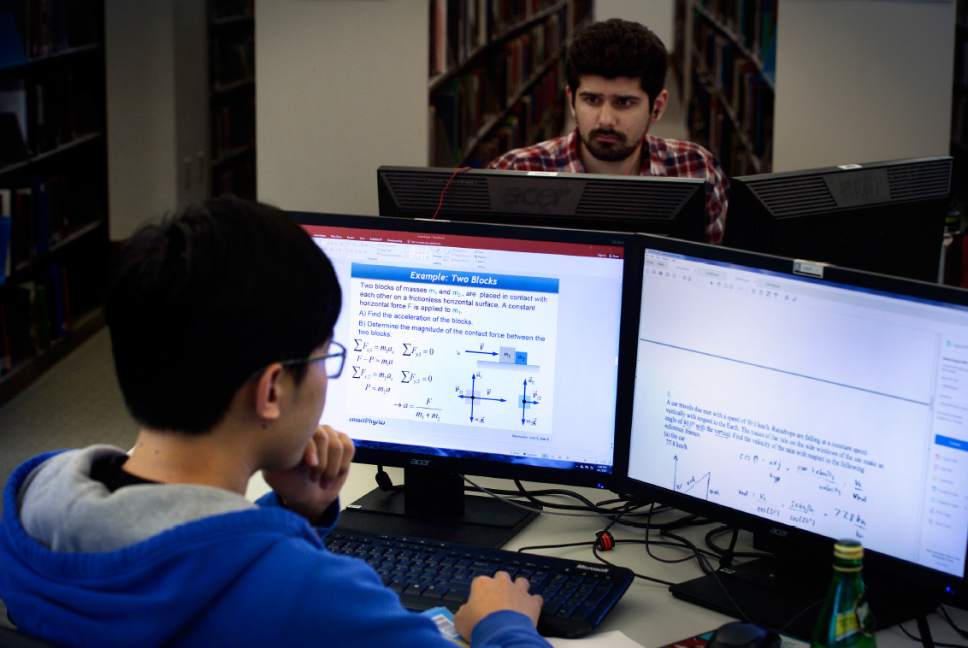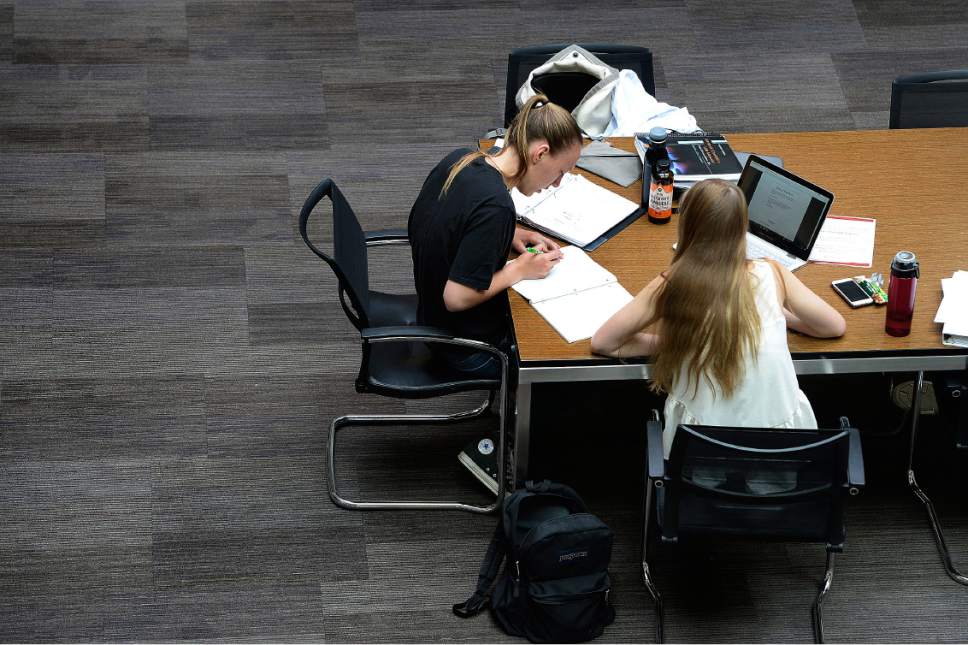This is an archived article that was published on sltrib.com in 2017, and information in the article may be outdated. It is provided only for personal research purposes and may not be reprinted.
A new study says that about two-thirds of all Utah students work during their college careers, a trend education experts say highlights the state's prolonged graduation rates.
Even though Utah's college tuition rates are among the nation's most affordable, the Beehive State had the third highest rate of college students who worked at least 27 weeks per year, the study found. Only Alaska and Minnesota had higher college work rates, at 72.9 percent and 66.9 percent, respectively.
In 2016, slightly fewer than half of all first-time, full-time students at Utah's half-dozen four-year universities completed their bachelor's degrees within six years, according to the Utah System of Higher Education.
Working and going to school at the same time raise the "tough question of, 'Will the earnings they make be enough to pay for college?' " said Spencer Jenkins, an agency spokesman. "Then they have to make the decision of whether to go into debt or decrease their course load."
The trend has forced state and university officials to take steps aimed at keeping Utah students on track to graduate.
Conducted by the apartment search web startup Abodo as part of a review of rental affordability, the new study examined U.S. census data from the 2015 American Community Survey to determine how many students worked and how much they were working. It then reviewed tuition, loans and rent costs in all 50 states to determine how student earnings compared to college costs.
—
Work culture • Utah's 65.7 percent college work rate was well above the national average of 52 percent, the study found.
But the high percentage is not surprising to Stan Inman, director of career services at the University of Utah. Culturally, the state has a "strong propensity to be self-reliant," he said. People "actually do like to work; they feel like it's something they should do."
That mentality is well reflected on the U. campus, Inman said, where 60 percent to 70 percent of students each year report working an average of 15 to 20 hours while attending school.
This can be beneficial, Inman said, because it gives students real-world, professional skills — especially if they find employment in their area of study. But making sure students don't take time off or decrease their course load to accommodate work hours is a real concern, he added.
"If students are working, they may [take time off] for a semester ... and then re-enroll," Inman said. "That's not a healthy pattern for consistency and completion."
—
Campus jobs • U. officials try to counter that by providing thousands of on-campus employment opportunities that can be more flexible with students' class schedules, he added.
So does Brigham Young University, which offered more than 17,000 on-campus jobs for students during winter semester, said Todd Hollingshead, university spokesman. During that semester, 46 percent of BYU's about 33,000 students worked on-campus.
BYU student employment manager Jenifer Jarvis estimates that students work about 10 to 15 hours during any given semester — undergraduates are not allowed to work more than 20 hours on-campus — and they might have several on-campus jobs.
The LDS Church-owned school typically has less of a problem with students needing to take time off to work and save money, she said, because they often have other resources available such as scholarships, grants and loans. Many students also work as much as they can over the summer to save for the school year, Jarvis added.
Through the years, Jarvis said, students who work have often performed better academically, probably because job experience also teaches them time management. "They focus, they do their work, and they know the amount of time they have to study."
—
Deal on credits • Seven of the eight public colleges in the state allow students to take 18 credit hours per semester for the same price as 12 credit hours to encourage students to take on a more robust course load, said Jenkins, with the state's higher education system.
"A lot of [Utah] students take 12 credit hours, but taking only 12 credits adds an additional year" to an individual's college tenure, Jenkins said. "If you take one more class per semester, it gets you on track for four years."
The U. chose not to offer that option to allow "our students to better manage their tuition costs," said U. spokeswoman Annalisa Purser. U. officials instead encourage students to take 30 credits each year, rather than 15 per semester, "to provide them more flexibility with their schedules," she said.
The U.'s graduation rate has risen by 10 percent since 2012, she said, which school officials attribute to "our efforts to keep tuition affordable by offering more scholarships, using data to provide improved advising, and ensuring our students have engaged learning experiences."
—
Money game • Saving a year's worth of tuition can make a significant difference. During the 2013-2014 school year, annual tuition at Utah public colleges for in-state students averaged $5,375 — the fourth lowest in the country, the Abodo study found.
That amount more than triples to an average of $17,441 for out-of-state students attending Utah public colleges, the study indicates, while private institutions in Utah cost an average of $7,765 that same year.
Students took out an average of $6,429 in federal student loans to attend Utah colleges during that school year, according to the study.
To help reduce costs and get students to graduate sooner, Jenkins said state officials also encourage high school students to take college-level courses — especially math — before graduating from 12th grade.
Though not yet in place, Jenkins said the state wants to make it easier for students to get an associate degree, for example, then work for a couple of years and come back to finish their bachelor's degree.
"We know students are working more than they used to," he said, "and we want to do what we can to help them along the way."
Twitter @alexdstuckey









